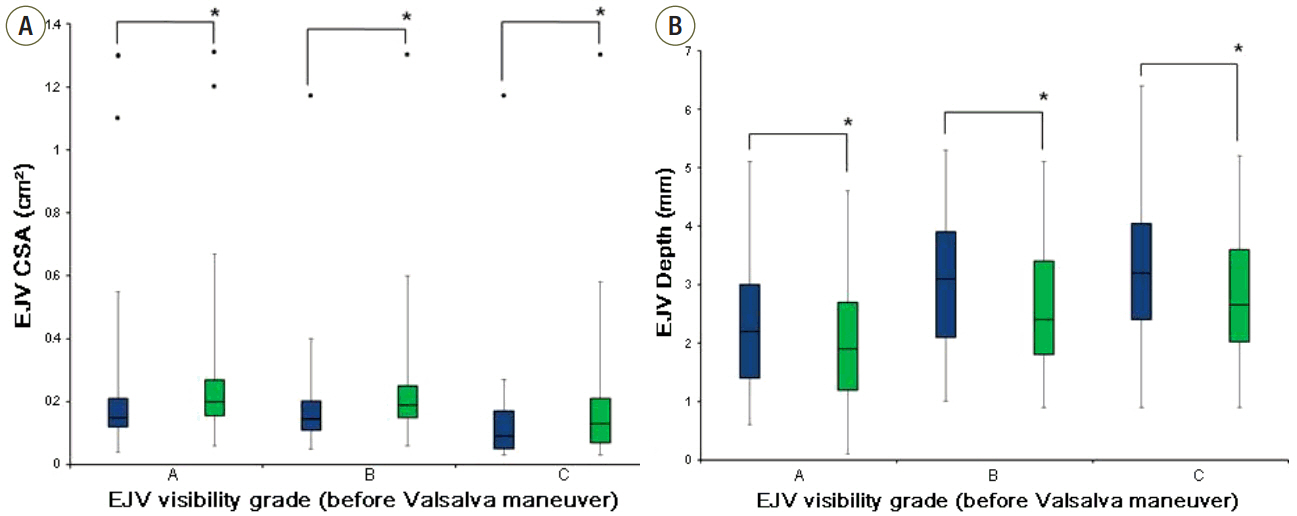Korean J Crit Care Med.
2015 Aug;30(3):158-163. 10.4266/kjccm.2015.30.3.158.
The Effect of the Valsalva Maneuver on the External Jugular Vein
- Affiliations
-
- 1Yeouido St. Mary's Hospital, College of Medicine, The Catholic University of Korea, Seoul, Korea.
- 2Soonchunhyang University Cheonan Hospital, College of Medicine, Cheonan, Korea.
- 3Uijeongbu St. Mary's Hospital, College of Medicine, The Catholic University of Korea, Uijeongbu, Korea. lehaji@catholi.ac.kr
- KMID: 2227642
- DOI: http://doi.org/10.4266/kjccm.2015.30.3.158
Abstract
- BACKGROUND
The external jugular vein (EJV) is a useful intravenous (IV) cannulation site for anesthesiologists, although it has a relatively high failure rate. Unlike other central veins, visualization of the EJV is important during IV cannulation, and the Valsalva maneuver distends the jugular venous system. However, the relationship between the maneuver and EJV visibility remains unknown. This study compared EJV visibility before and after the Valsalva maneuver.
METHODS
This was a prospective observational study that included 200 participants. After the induction of anesthesia, EJV visibility grade, depth from the skin to the EJV superficial surface (EJV depth), and EJV cross-sectional area (CSA) before the Valsalva maneuver were measured. The same parameters were measured after the Valsalva maneuver was performed. The EJV visibility grade was defined as grade A: good appearance and good palpation, grade B: poor appearance and good palpation, and grade C: poor appearance and poor palpation.
RESULTS
Patient body mass index and EJV depth affected the EJV visibility grade before the Valsalva maneuver (p < 0.05), although EJV CSA did not. The Valsalva maneuver distended EJV CSA and reduced EJV depth, although these changes were not correlated with EJV visibility grade. With regard to EJV visibility, 34.0% of grade B cases and 20.0% of grade C cases were improved by the Valsalva maneuver.
CONCLUSIONS
Although the Valsalva maneuver improved EJV CSA and EJV depth, it did not greatly affect EJV visibility grade.
Keyword
MeSH Terms
Figure
Reference
-
References
1. Uvelin A, Kolak R, Putnik D. External jugular cannulation is irreplaceable in many situations. Resuscitation. 2010; 81:773. author reply 774.
Article2. Dailey RH. External jugular vein cannulation and its use for CVP monitoring. J Emerg Med. 1988; 6:133–5.
Article3. Pettit J. External jugular cannulation in infants and children. J Infus Nurs. 2009; 32:93–7.
Article4. Lahtinen P, Musialowicz T, Hyppölä H, Kiviniemi V, Kurola J. Is external jugular vein cannulation feasible in emergency care? A randomised study in open heart surgery patients. Resuscitation. 2009; 80:1361–4.
Article5. Costantino TG, Kirtz JF, Satz WA. Ultrasound-guided peripheral venous access vs. the external jugular vein as the initial approach to the patient with difficult vascular access. J Emerg Med. 2010; 39:462–7.
Article6. Giesy J. External jugular vein access to central venous system. JAMA. 1972; 219:1216–7.
Article7. Lewin MR, Stein J, Wang R, Lee MM, Kernberg M, Boukhman M, et al. Humming is as effective as Valsalva’s maneuver and Trendelenburg’s position for ultrasonographic visualization of the jugular venous system and common femoral veins. Ann Emerg Med. 2007; 50:73–7.
Article8. Galinski M, Catineau J, Tazarourte K, Dardel N, Bertrand P, Adnet F, et al. Comparison of historical anatomic landmarks vs. ultrasound guidance for the selection of a needle insertion site for jugular central venous access. Resuscitation. 2012; 83:e113–4.
Article9. Mitre CI, Golea A, Acalovschi I, Mocan T, Caea AM, Ruţă C, et al. Ultrasound-guided external jugular vein cannulation for central venous access by inexperienced trainees. Eur J Anaesthesiol. 2010; 27:300–3.
Article10. Gann M Jr, Sardi A. Improved results using ultrasound guidance for central venous access. Am Surg. 2003; 69:1104–7.11. Scheller MS, Saidman LJ. An aid to identifying the external jugular vein. Anesthesiology. 1982; 57:546–7.
Article12. Bellazzini MA, Rankin PM, Gangnon RE, Bjoernsen LP. Ultrasound validation of maneuvers to increase internal jugular vein cross-sectional area and decrease compressibility. Am J Emerg Med. 2009; 27:454–9.
Article13. Zhou Q, Xiao W, An E, Zhou H, Yan M. Effects of four different positive airway pressures on right internal jugular vein catheterisation. Eur J Anaesthesiol. 2012; 29:223–8.
Article14. Verghese ST, Nath A, Zenger D, Patel RI, Kaplan RF, Patel KM. The effects of the simulated Valsalva maneuver, liver compression, and/or Trendelenburg position on the cross-sectional area of the internal jugular vein in infants and young children. Anesth Analg. 2002; 94:250–4.
Article15. Beddy P, Geoghegan T, Ramesh N, Buckley O, O’Brien J, Colville J, et al. Valsalva and gravitational variability of the internal jugular vein and common femoral vein: ultrasound assessment. Eur J Radiol. 2006; 58:307–9.
Article16. Yuki K, Chilson K, Odegard KC, DiNardo JA. Trendelenburg position, simulated Valsalva maneuver, and liver compression do not alter the size of the right internal jugular vein in patients with a bidirectional Glenn shunt. Anesth Analg. 2007; 105:365–8.
Article17. Rippey JC, Pascu O, Jacobs I. Abdominal compression effectively increases the size of the common femoral vein, as measured by ultrasonography. Ann Emerg Med. 2008; 52:446–52.
Article18. Kim JT, Park CS, Kim HJ, Lee JM, Kim HS, Kim CS, et al. The effect of inguinal compression, Valsalva maneuver, and reverse Trendelenburg position on the cross-sectional area of the femoral vein in children. Anesth Analg. 2009; 108:1493–6.
Article19. Looga R. The Valsalva manoeuvre--cardiovascular effects and performance technique: a critical review. Respir Physiol Neurobiol. 2005; 147:39–49.
Article
- Full Text Links
- Actions
-
Cited
- CITED
-
- Close
- Share
- Similar articles
-
- Comparison of internal jugular vein dilation between Valsalva maneuver and proximal internal jugular vein compression
- A Case of Bilateral Internal Jugular Phlebectasia
- Primary jugular venous ectasia: A rare cause of neck mass
- A Large Subcutaneous Hematoma during Internal Jugular Vein Catheterization: A case report
- Terminal bifurcation of the external jugular vein: a rare variation




